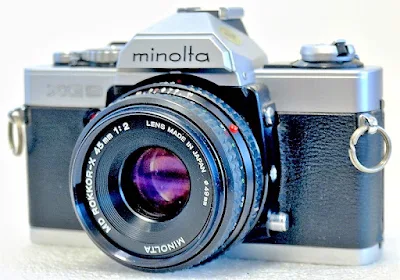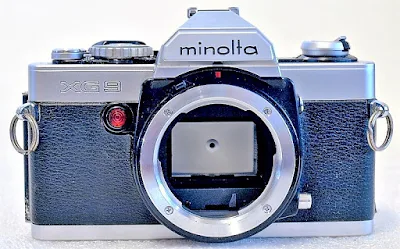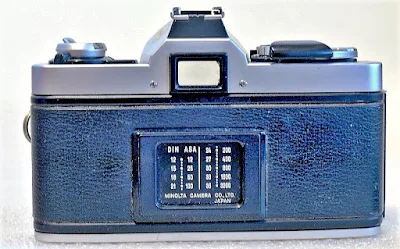The Vintage Enthusiast: An excellent manual focus autoexposure 35mm SLR film camera with advanced user features.
The Minolta XG-9 (XG-S), an autoexposure 35mm SLR film camera introduced in 1979, was the direct replacement of the XG-7 (1977), the camera that introduced the XG-series to the consumer market. Launched in 1977 as the lower-priced option to the professionally orientated XD-series bodies, the XG-series was sold alongside the mechanical SR-T Series that was still in production.
Over and above the initial XD-7 specification, the XD-9 came with a new superbright Acute-matte screen incorporated into the viewfinder, for improved light transmission and focusing ease, and an aperture readout window which is a great help with camera setting for auto-exposure shooting. The metering system is, however, still inactive when the camera is used in manual mode.
The XG-9 also came with a user-removable back with a film tab holder, which is interchangeable with the new Data Back G, and later, the Quartz Data Back G that records either the time/date (in any of three combinations), code number (up to 999999) or sequential frame numbers of the film. The XG-9 was also the first of the XD-series bodies to have a depth-of-field preview button.
The XG-9 is fitted with an electronically controlled horizontal-transverse focal plane shutter with a speed range from 1 to 1/1000th second, step-less in auto mode, and stepped in manual mode. Film ISO speed range is from 25 to 1600, +2EV exposure compensation at 1/2 click stops, oversized quick return mirror, and a fixed eye-level pentaprism with 93% film-frame view.
Minolta XG9 35mm film SLR camera body with 45mm lens
Checking over a Minolta XG9 camera
Metering is full TTL (Through the Lens) center-weighted by a pair of CdS mounted on either side of the eyepiece at the rear of the pentaprism. The auto-exposure range is EV 2 to EV 17 at ISO 100 with a 1.4 lens.
Basic Camera Features
A very capable camera no less, the XG-9 is available both in black and chrome.The front plane of the camera is a very plain affair with only the self-timer/battery check LED to the left of the lens mount housing, which carries an X-sync terminal, the lens release button, and the shutter release socket on the opposite side of the mount vertical, and the DoF (Depth of Field) preview button on the lower right.
On the top plane, to the left, is the film rewind crank, which is also the pull-up film back latch, integrated with a selector dial for Self-Timer, Power ON, Power OFF, and battery check functions. A hot shoe is fitted on top of the pentaprism.
To the right is the combination of the shutter release button, button-released AE mode/shutter speed dial, exposure compensation dial which can be set when the camera is set to 'A' mode operation, and the film ISO speed selector dial which is set by pulling up and turning the crown of combination dial.
Complementing the top plane is the single-stroke film forward crank, film frame counter, and a small elongated film safe-load indicator window.
The back of the camera is another plain affair, with the viewfinder eyepiece on the back of the top plane, and the hinged interchangeable film back. A film tab holder is central in the middle of the film back.
Located on the bottom plate are the tripod socket, film rewind release button, battery chamber cover, and auto-winder coupler. The XG-9 is compatible with Minolta Auto-Winder G.
The film box is a standard film cartridge chamber, shutter window, film advance sprocket, and the 4-slot take-up spool. Film loading is the standard 2-blank shots to forward the film to frame 1. The Film Safe Load indicator will show a red indicator if the film is properly loaded.
Viewfinder Readout
The viewfinder, with a fresnel-field screen and split-image/microprism focusing spot, includes a full 1-second to 1/-1000th second shutter speed scale located vertically on the right of the focusing screen, and a small aperture readout located midway on the bottom frame.
Auto-exposure shutter speeds are indicated by red LEDs next to the numerals, with the intermediate speed shown by a pair of LEDs in 'A' mode. Over- and under-exposures are indicated by LED arrowheads at the top and bottom of the vertical bar.
Metering is disabled in manual shooting mode, which means that you should rely on your knowledge of the Sunny-16 rule, or do a predetermined exposure setting based on the 'A' mode exposure reading.
Film Rewinding and Unloading
Film rewind on the XG-1 (the same as most other manual film load cameras) is a two-step process. First press the film rewind release located on the bottom plate of the camera, next, pull the film rewind crank handle out from its rest position and use the lever as the handle to turn the crank clockwise until the film roll is rewound completely into its canister.Next pull the rewind crank assembly up to release the film back latch, and remove the film roll.
Battery
The XG-9 requires a pair of easily available 1.5-volt LR/SR-44 button cells which power both the camera's auto-exposure control and the electronically controlled shutter system. The camera will not function when the battery voltage is low or near depletion.The Minolta XG-9 camera's body weight is 500 grams without batteries.
Lens Compatibility
All XG-series cameras are generally compatible with all Minolta SR-mount lenses, which, through their production run, are categorized as SR (1958-1966), MC (1966-1977), MD (1977-2001), and MD X-600 (1983-1998). The different iterations come with slightly different functionalities which are based on the technology of the time.The XG-series camera was produced in tandem with the introduction of MD-series lenses which are completely compatible and will work flawlessly with the AE capabilities of the cameras.
Using the Camera
Aside from the challenge of using the camera in full manual mode, where you need to rely on your knowledge of the exposure triangle (Film ISO Speed, Lens Aperture Opening, Camera Shutter Speed) or the Sunny-16 rule to set the camera shutter speed and the lens aperture opening, the XG-9 is explicitly a fun and easy camera to use.With a body weight that will not wear you down and a selection of Minolta MD lenses that are easily available at fantastic low prices on auction sites, there is not much of a reason why you should back away from such a selection. The camera itself, being of a very robust design and build (as the one I was testing with), is still a very smooth operator with well-damped mechanicals.
Recommended!






















Thanks for the great article, you really hit on every feature:). We bought one with several lenses and are very happy with it:)! It was easy to sort out and we already took a few pictures. It will be fun to start using all the features.
ReplyDeleteTak, to bardzo dobry artykuł.
Delete